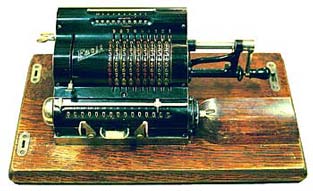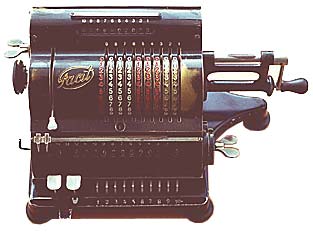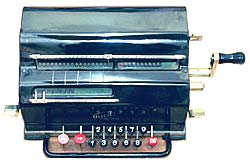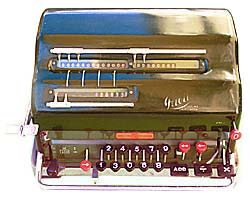
![]()
FACIT CALCULATORS (1)
Den första räknemaskinen med namnet Facit var en snurra av Odhnertyp tillverkad 1918 av firma Axel Wibel på Malmtorgsgatan 3 i Stockholm. Enligt 1908 års handelskalender hade firma Wibel även agenturerna för skrivmaskinen Bar-Lock samt räknemaskinerna Burroughs och Brunsviga.
The first calculator bearing the Facit name was an Odhner-type pinwheel machine made in 1918 by the firm of Axel Wibel in Stockholm. Axel Wibel also had the sales agencies for the Bar-Lock typewriter as well as for the Burroughs and Brunsviga calculators.

1924 övertogs Wibels firma av AB Åtvidabergs Industrier, som även behöll namnet Facit. Bilden föreställer modell Standard med snabbnollställning och tabulator. Den senare modellen hade även tio-överföring i kvotregistret vilket möjliggjorde snabbare räknevägar.
In 1924, Wibel's company was taken over by the Åtvidaberg Industries, which also adopted the Facit name. Illustrated above is the "Standard" model with fast clearing and tabulator. Later Standards even had tens transmission in the quotient register, making it possible to perform shortcut operations.

1932 lanserades modell T med tangentinställning enligt Karl Rudins patent från 1928. Lägg märke till det tvåradiga tangentbordet av så kallad Daltontyp. Bilden föreställer en förlängd variant av 1936 års modell TK med glidande kvotkoppling, dvs. automatisk utfyllnad med nollor vid division.
In 1932, model T with key setting was introduced, based upon the patent of Charles Rudin from 1928. Note that it has a two-row Dalton-type keyboard. Illustrated above is an extended version of model TK. Introduced in 1936, the TK was equipped with a sliding quotient coupling, dispensing the need to fill out the dividend with zeroes.

Den första Facitsnurran med elektrisk drift var modell E från 1934. Den följdes 1936 av modell EK med glidande kvotkoppling, respektive 1939 av modell EA med automatisk division och automatisk stegning vid multiplikation. Samtliga E-modeller var utrustade med så kallad stoppdivision, vilket innebär att maskinen stannar automatiskt när maskinen går ned till (eller under) noll.
The first Facit electric calculator was model E introduced in 1934. In 1936, it was followed by model EK with sliding quotient coupling, and in 1939, by the semi-automatic model EA featuring automatic division and automatic shifting when multiplying. All E-models were equipped with the "stop division" feature, which brought the mechanism to a halt as soon as the accumulator registered zeroes or nines.
Fortsätt med Facits räknemaskiner, del 2 / Continue with Facit calculators, part 2
Räkna på räknesnurra / Calculating on the Odhner